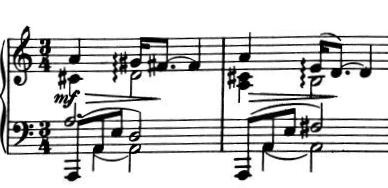Words can be bent in pronounciation to suggest other words — subtly shading, or adding on to signification.
 In B.o.B.’s “So Good,” the word groups “how you feel [fe-el],” “fantasy oh,” “put your feet up,” and “Señorita” are made almost to rhyme, and conform to the same four-syllable emphasis-pattern. The sound is the word is the music is the sound. It’s joy-inducing virtuoso display.
In B.o.B.’s “So Good,” the word groups “how you feel [fe-el],” “fantasy oh,” “put your feet up,” and “Señorita” are made almost to rhyme, and conform to the same four-syllable emphasis-pattern. The sound is the word is the music is the sound. It’s joy-inducing virtuoso display.
Wordless music also offers possibilities for sonic enharmony.
I first encountered Brahms’s A-Minor Intermezzo, Opus 116, no. 2 through Arthur Schnabel‘s recording. One detail in the playing so captivated me — it might be what made me want to learn the entire Opus 116 set.
In Schnabel’s recording, the notes including the Scotch snaps in measures 51 and 52, are ellided in such a way that the sonority, the syncopated rhythm, the emphasis pattern, the voice-leading, dissonance and resolution are so much of one piece, the elements resist being teased apart. (The half-notes in the alto voice begin the second syllable of four-syllable groupings…)

Brahms: Intermezzo in A Minor, opus 116, no. 2, mm. 51-52
I can’t say that the notation, the text, leads clearly to Schnabel’s performance. But I coveted the synergy of that performance in my own recording, twenty years later.
And this four-syllable pattern of emphasis, this lexia, is with us still (“how you fe-el”).
